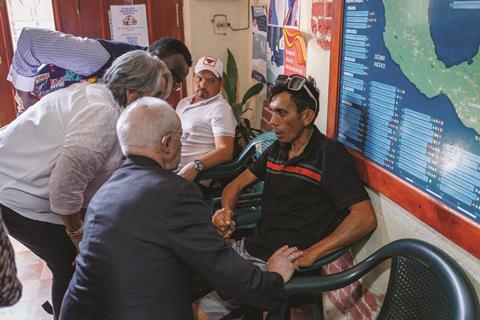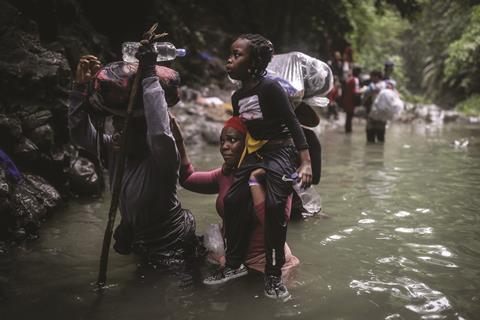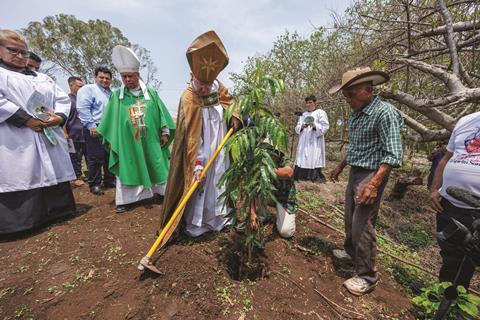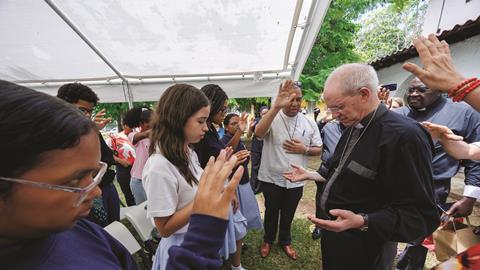For journalist Kelly Valencia, accompanying the Archbishop of Canterbury on his tour of Central America was more than just a job. It was a personal reminder of the trials faced by her own family – and how the Church helped them
Out of nowhere, it hit me. A sudden wave of emotion, completely unexpected and yet strangely familiar. I took a deep breath and tried to focus my thoughts. “You’re here as a journalist. Get a grip.”
I’d been invited to follow Most Rev Justin Welby, the Archbishop of Canterbury, on a twelve-day visit to the Anglican province of Central America. I was the only journalist present for the trip – a privileged position. But remaining detached from the issues would prove impossible. Having been born in Colombia, Latin America is a place that is close to my heart. I not only speak the language (a skill that would soon come in useful) but also understand the culture, people and the challenges they face.
This trip was more than a work assignment; it was personal.
Corrupt governments, poverty and criminal gangs are a daily reality for millions of people in Central America. In recent years, life has been further complicated by the impact of climate change. The region, often referred to as ‘the dry corridor’ is among the most vulnerable in the world to climate disruption. With stronger and more frequent storms, unpredictable rainfall and an increase in drought, crops are failing, leaving subsistence farmers unable to feed their families, and wage farmers without jobs. This has led to thousands of people migrating from countries such as Guatemala, Honduras, El Salvador, Nicaragua, Haiti and Venezuela and travelling thousands of miles across treacherous terrain in order to try to reach the USA.

Lifeline
This was the context of our visit to the Anglican-run refuge, La Casa del Migrante (House of Migrants), in Guatemala City. Despite having only been open for twelve months, this modest two-floor apartment had already assisted nearly 2,000 people passing through the city hoping, ultimately, to find a better future in North America.
Migration is the sole reason for the existence of La Casa del Migrante. It offers a lifeline for up to 15 people at a time, and typically houses two or three families with young children, providing them with a safe haven amid their struggles.
The family we met, which included two children aged just seven and nine, had left their native Venezuela and walked for three months, covering more than 1,718 miles. They’d braved the treacherous Darién Gap – a dangerous, remote stretch of jungle and swamp between Colombia and Panama – and continued through several countries, including Costa Rica, Nicaragua and Honduras, before finally reaching Guatemala, where they were surviving by selling goods on the streets, hoping to save enough money to afford the next leg of their journey to the Mexican border. Despite their exhaustion, their eyes still sparkled with hope and they showed deep appreciation for the prayers said by the archbishop, who knelt at their feet and held their hands to bless them.
As I listened to their story, I could feel myself becoming emotional; it bore so many similarities to my own. My mum and aunt both immigrated in similar circumstances and are the reason I’m now a European citizen.

The family we met had walked for more than three months, covering 1,724 miles
“It’s extraordinary work,” Archbishop Justin told the refuge leaders. “It is both local and global…you have to work at all points in the journey of migration…to love those who are travelling but also to love the communities through which they pass.”
As the archbishop spoke these words, I was reminded of the kindness shown to my mum by a local church upon her arrival in Spain from Colombia in the early 2000s. Even at the age of five, I still remember the enormous sense of peace that came from knowing that, despite my dad and I being thousands of miles away in Colombia, there was somebody who cared and was watching out for her.
My story had a happy ending, but these families were still in the middle of their struggles. They didn’t have relatives to leave their children with, or the means to handle administrative hurdles such as acquiring a passport. For them, walking was the only choice.
As I saw the faces of these children light up, I couldn’t shake the thought that these kids could have so easily been me. I looked just like them but, through no merit of my own, I was now on the ‘other side’ of the divide, standing with the saviours not the victims. It was a little overwhelming.
After saying our goodbyes, we got into the minibus and returned to our hotel. I felt like I could finally breathe again, and tears began to stream down my face. “Kelly, I imagine that must have been difficult for you,” the archbishop’s chaplain remarked gently. I nodded, looking straight ahead, not wanting him to see my face. As he returned to his seat, I silently thanked him for his concern – and sensitivity in giving me the space I needed.
Regional significance
This tour was the first time that an Archbishop of Canterbury had ever visited four nations in Central America in one go. The meticulously planned journey saw Archbishop Justin pass through Guatemala, El Salvador, Panama and Costa Rica.
It was a significant moment for the region. All four nations are deeply rooted in Catholicism, a legacy of Spanish colonialism, but Catholicism is not just a religion; it’s part of the cultural and political fabric. I was initially surprised to discover that the Anglican Communion even has a foothold here. Estimates suggest there are between 30,000 to 35,000 Anglicans in the province, compared to the 40 to 50 million people identifying as Catholics.
While the primary purpose of Archbishop Justin’s visit was to encourage local Anglicans, the complications of life were not lost on him. “It is a province that has huge issues, and they should know they are not forgotten,” he told me during our first of many interviews.
“Here you have small churches with enormous problems resulting from climate change and from massive migration with colossal quantities of people going through. Together with the narco economy, the drug cartels run the people-smuggling [business] and oppress and kill…[They] have control of some parts of the country and the province…so it’s a Church that has a really hard life.”

After Guatemala, we moved on to El Salvador, where the archbishop was again welcomed with broad smiles and an avalanche of presents. But it was here that I began to see a different side of him.
Until this point, I’d only seen the Archbishop of Canterbury in formal settings such as press conferences and meetings of the Church of England General Synod. I’d never witnessed him interact personally with ‘everyday’ Christians and church leaders. In El Salvador, with its issues of poverty, corruption and gang violence, titles and formalities faded into the background. The need to fully trust in Jesus daily had the effect of bridging the gap, levelling the playing field.
We visited the memorial of Archbishop Óscar Romero, who was assassinated in 1980 by a far-right militia group while ministering inside a hospital chapel. Romero, who was known for his social activism and support for the poor, was later canonised by the Catholic church. It’s a well-known story, but Archbishop Justin admitted that hearing about St Romero from local people moved him “beyond words”.
Even though Archbishop Justin and his wife had their own translators, there were times when other team members needed help, or the translators simply needed a well-deserved rest. That’s when I stepped in, translating for the archbishop, Mrs Welby and the local team. One memorable moment came when I translated a heartfelt conversation between Archbishop Justin and Rt Rev David Alvarado, Archbishop of El Salvador and primate of the Central America province. While I can’t share the specifics of their discussion, the deep connection between them was palpable, and made a significant impression on the local leader.
Speaking afterwards, Archbishop David told me the visit made “a big difference and is already being noticed.
“His visit gives us exposure to the politicians here. It sends the message that the Anglican Church is active in our community and that we have the support of someone like the Archbishop of Canterbury, which is crucial.”
A dangerous journey
Next on our itinerary was Panama, where Archbishop Justin planned to visit the infamous Darién Gap— the treacherous, roadless 60-mile stretch between Panama and Colombia that represents the starting point for thousands of migrants on their journey to the USA.
The numbers are staggering. In 2023, around 520,000 migrants crossed the Darién Gap; one in five were children. The vast majority come from Venezuela (329,000), followed by Ecuador (57,000) and Haiti (46,000). Already this year, more than 212,000 migrants have attempted to cross the inhospitable stretch of jungle.
Corrupt governments, poverty and criminal gangs are a daily reality for millions of people in Central America
The route is unauthorised and the situation has become increasingly difficult to control. After passing through the Darién Gap, the Panamanian government registers migrants’ biometrics, provides some healthcare and food, and then transports them by bus to Costa Rica so they can continue their journey to the USA. Most recently, Panama’s new president, José Raúl Mulino, ordered barbed wire to be put up in order to force migrants along one path. As a result, some reports are saying that crossings have dropped.
From Costa Rica, migrants typically head to Nicaragua, then onto Honduras or El Salvador, before reaching Guatemala – the last stop before Mexico and, eventually, the USA. Since most travel without formal identification documents, border forces along the route either deport them or give them a special permit to pass through the country for a few days.
United we stand
The final leg of our trip was to Costa Rica, where we visited a church-run school for migrant children. British flags and huge welcome signs greeted the archbishop, who was keen to try out some of his newly learned Spanish vocabulary. The kids were enthralled and couldn’t stop smiling at his efforts.
Hogar Episcopal School has existed for 55 years, helping single migrant mothers who have nowhere else to turn. It cares for 1,325 children, aged between one and twelve years old. Most are from families aiming to get to the USA, but who are biding their time in Costa Rica to save up for the next leg of their journey. Unsurprisingly, there is a significant waiting list for the school, which offers free education and care for migrant families arriving with almost nothing.
Just as the Church played a big role in my story, it’s still making a difference today
Listening to the stories of the children and their mothers hit me hard. Victoria, 30, reminded me of my own mother, who was the same age when she left Colombia in search of a better future for me. And just as the Church played a big role in my story, it’s still making a difference today.
Throughout the trip, Archbishop Justin had a consistent message for local leaders and policymakers: “the Church has a vital role to play, and unity is essential”. Naturally, I asked him if this call to unified action was genuinely achievable or just a distant pipe dream.
He told me: “Whatever actions anyone takes, it must be human-centred.
“The Church must react both locally and globally, and not bureaucratically…that’s the easiest thing to do. We set up a new committee and they set up subcommittees and we produce a wonderful plan and we do nothing.

“No country can deal with [migration] by itself, no country can take everyone…therefore, the churches and civil society need to work with governments, and governments need to work with other governments. The Church needs to use [its] international reach across the region to address these issues collectively and, essentially, globally.
“We have to see it in a holistic light, which is that [migration] is the result of bad governance in countries like Venezuela, of civil war in countries like Colombia, of climate change, of misappropriation of funding, of corruption, of cruelty…it is not a problem that is going to end any time soon. There has to be a long-term strategy as well as short-term active compassion.”




































1 Reader's comment